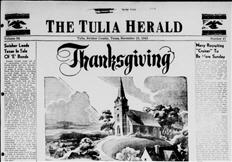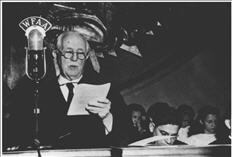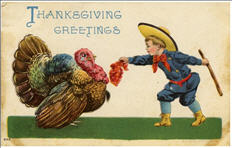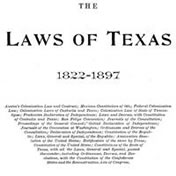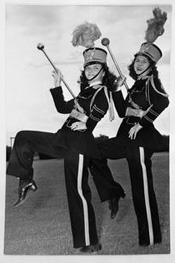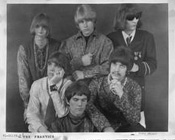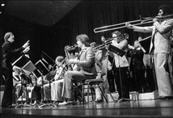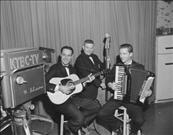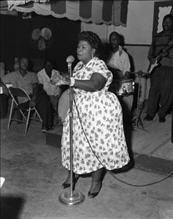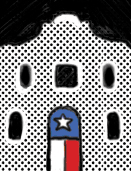The e-newsletter of UNT's Portal to Texas History| November 2009
Content
New Collections
What's in the lab now?
Focus on . . . Thanksgiving!
Students making a Difference . . .
TDNP: Hemphill County News, Bartlett Tribune now online
UNT Digital Collections

Paris, Texas after the devastating 1916 fire, Private Collection of Joe E. Haynes

Permian Basin Petroleum Museum, Library and Hall of Fame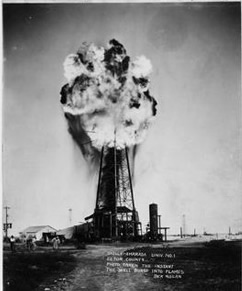
The Permian Basin Museum, located in Midland, Texas, contributed a rich sampling of photographs of West Texas boom towns, oil field camps, and ranching life from the late 1890's through the 1950's. Images of workers constructing oil rigs and 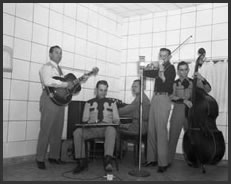 pipelines in harsh winter weather and loading stacks of dynamite reveal the hard and dangerous work that went into building and maintaining oil wells. But along with the hard work came time for recreation as the photograph of the Cecil Bowers Cowboy Band above demonstrates. This collection provides a great snapshot of how the oil boom brought commerce and development to the West Texas Permian Basin.
pipelines in harsh winter weather and loading stacks of dynamite reveal the hard and dangerous work that went into building and maintaining oil wells. But along with the hard work came time for recreation as the photograph of the Cecil Bowers Cowboy Band above demonstrates. This collection provides a great snapshot of how the oil boom brought commerce and development to the West Texas Permian Basin.
Dallas Police Department photos of the Kennedy assassination now available on the Portal
Direct from the UNT News Release, November 2009 by Nancy Kolsti.
DENTON (UNT), Texas — A paperback copy of the novel “1984” was probably not an uncommon item in households in 1963, including the white, two-story home at 214 Neely St. in Dallas.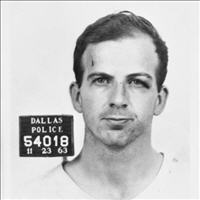
But because that home was the boarding house of Lee Harvey Oswald, George Orwell’s 1949 cautionary tale against totalitarianism was seized by Dallas Police Department officers as evidence on Nov. 22, 1963 — along with other items belonging to Oswald.
Photographs of these items and many other Dallas Police Department photos related to the investigation of President John F. Kennedy’s assassination are now available for public viewing on the Internet, thanks to the University of North Texas Libraries’ Portal to Texas History and the Dallas Municipal Archives.
The UNT Libraries’ Digital Projects Unit, which manages the portal, recently received a Rescuing Texas History grant from the Summerlee Foundation to digitize 404 images taken by the department during the week following Kennedy’s assassination. The Dallas Municipal Archives, a division of the City Secretary’s Office, possesses all of the original investigation files except for those that have been transferred permanently to the federal investigation collection held at the National Archives.
 “We are delighted to be working with the Portal to Texas History to make the collections of the Dallas Municipal Archives more accessible, and look forward to a long relationship,” said City Secretary Deborah Watkins.
“We are delighted to be working with the Portal to Texas History to make the collections of the Dallas Municipal Archives more accessible, and look forward to a long relationship,” said City Secretary Deborah Watkins.
Dallas Mayor Tom Leppert noted that the images “document a tragic but historic moment in Dallas and American history. It’s critical that these important photographs not only be preserved, but be available to all for study and scholarship,” he said.
The black-and-white photographs are now located at http://texashistory.unt.edu/explore/collections/JFKDP/browse and are easily searchable. They include the “sniper’s nest” in downtown Dallas’ Texas School Book Depository Building, where Oswald allegedly fired on Kennedy’s motorcade; the back and front yards of the boarding house at 214 Neely; Dealey Plaza; the intersection at Tenth Street and Patton Avenue where Oswald allegedly fatally shot Dallas patrolman J.D. Tippit; interiors of the Texas Theater, where Oswald was arrested by Dallas police; and the basement of Dallas City Hall, where Jack Ruby shot and killed Oswald on Nov. 24, 1963.
Dreanna Belden, coordinator of grants and development for the UNT Libraries, 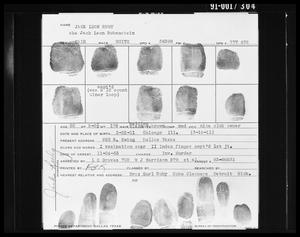 said that beginning in 2010, the documents that accompany the photos and the Dallas Police Department’s investigation will also be placed on the Portal to Texas History. These documents include homicide reports, newspaper clippings and correspondence, affidavits and witness statements.
said that beginning in 2010, the documents that accompany the photos and the Dallas Police Department’s investigation will also be placed on the Portal to Texas History. These documents include homicide reports, newspaper clippings and correspondence, affidavits and witness statements.
“We hope to raise money to cover the completion of this project,” said Belden, who said that placing the photos and documents on the Portal to Texas History will provide the general public with the widest possible access to them.
Dr. Martin Halbert, dean of UNT Libraries called the Kennedy assassination "a critical moment in our collective cultural memory."
"This tragic event still deeply resounds across our nation, and we at UNT are delighted to be providing public access to these historical materials," he said.
The photos were previously digitized in 1992 by Wang Laboratories in Lowell, Mass., after the Dallas City Council passed a resolution ordering the release of all files, documents, papers, films, audio or any other evidence held  by the Dallas Police Department or any city department or agency regarding the Kennedy assassination, Lee Harvey Oswald and Jack Ruby to the public and the media. The resolution, which also ordered that these materials be preserved, was largely in response to public interest following the December 1991 premiere of the film “JKF.”
by the Dallas Police Department or any city department or agency regarding the Kennedy assassination, Lee Harvey Oswald and Jack Ruby to the public and the media. The resolution, which also ordered that these materials be preserved, was largely in response to public interest following the December 1991 premiere of the film “JKF.”
Belden said that although the photos were placed online by the Dallas Municipal Archives after they were digitized by Wang Laboratories, “there was no way to search through them using a search engine, and the image quality was very poor, due to the equipment available at the time.”
“Major changes in technology have occurred in the past 17 years, and the difference in quality is astounding,” she said.
The Telegraph and Texas Register, 1835-1843
It was news that was fit to print for the weekly newspaper. On March 12, 1836, the Telegraph and Texas Register of San Felipe de Austin published the Declaration of Independence made by the Delegates of the People of Texas in General Convention at Washington more than a week earlier. The newspaper published the entire declaration noting "We present our readers, this week, with the unanimous declaration of independence, by the assembled delegates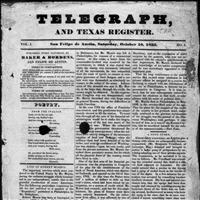 of Texas...the important document was presented and adopted." The same issue included a letter from Lieut. Col. Comm. W. Barrett Travis pleading to the President of the Convention to "hasten on reinforcements, ammunition and provisions to our aid, as soon as possible." Facing the wrath of Santa Ana with a demand that he surrender, Travis writes "Their threats have had no influence on me, or my men, but to make all fight with desperation, and that high souled courage which characterizes the patriot, who is willing to die in defence of his country's liberty and his own honor." The newspaper provides a firsthand account of history in the making and provides a fascinating view of life during the nineteenth-century in Texas. Many thanks to our partners at the Center for American History at UT for working with us to provide access to this important newspaper.
of Texas...the important document was presented and adopted." The same issue included a letter from Lieut. Col. Comm. W. Barrett Travis pleading to the President of the Convention to "hasten on reinforcements, ammunition and provisions to our aid, as soon as possible." Facing the wrath of Santa Ana with a demand that he surrender, Travis writes "Their threats have had no influence on me, or my men, but to make all fight with desperation, and that high souled courage which characterizes the patriot, who is willing to die in defence of his country's liberty and his own honor." The newspaper provides a firsthand account of history in the making and provides a fascinating view of life during the nineteenth-century in Texas. Many thanks to our partners at the Center for American History at UT for working with us to provide access to this important newspaper.

LBJ Museum of San Marcos
"I seldom think of politics more than eighteen hours a day." - Lyndon Johnson
A collection of over a thousand photographs documenting 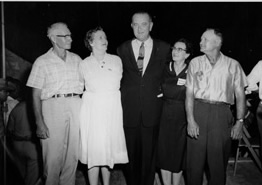 Lyndon Johnson and family at the LBJ Ranch in Stonewall, Texas (his home from 1951-1973, Lady Bird's until 2007) will be available in February. The photos cover major events, including historic diplomatic visits, the 1960 campaign of Kennedy and Johnson, birthday celebrations, President Johnson press conferences, national/state park dedications, and LBJ's funeral ceremony. Noteworthy persons included in photos are Harry Truman, Adlai Stevenson, Sam Rayburn, John F. Kennedy, Henry B. Gonzales, Hubert Humphrey, Pierre Salinger, Bill Moyers, and Johnson family members. This collection was donated to the museum by the family of Nortam Dietel, the late editor and publisher of the Fredericksburg Standard-Radio-Post.
Lyndon Johnson and family at the LBJ Ranch in Stonewall, Texas (his home from 1951-1973, Lady Bird's until 2007) will be available in February. The photos cover major events, including historic diplomatic visits, the 1960 campaign of Kennedy and Johnson, birthday celebrations, President Johnson press conferences, national/state park dedications, and LBJ's funeral ceremony. Noteworthy persons included in photos are Harry Truman, Adlai Stevenson, Sam Rayburn, John F. Kennedy, Henry B. Gonzales, Hubert Humphrey, Pierre Salinger, Bill Moyers, and Johnson family members. This collection was donated to the museum by the family of Nortam Dietel, the late editor and publisher of the Fredericksburg Standard-Radio-Post.
Matthews Land & Cattle, Lambshead Ranch
Lambshead, one of Texas’ most historic cattle ranches, is still owned and operated by the direct descendants of Judge J. A. and Sallie Reynolds Matthews. The Reynolds and Matthews families were pioneer ranchers and trail drivers who arrived in East Texas in the 1850’s and at the Clear Fork of the Brazos River, in 1866. The photographs, spanning over 100 years, document ranching history, ranching practices and community gatherings such as the famous Fort Griffin Fandangle. Images of historic ranch buildings, like the one above, are also featured, the oldest one being the Old Stone Ranch, built in 1855 which was the last pioneer outpost between forts.

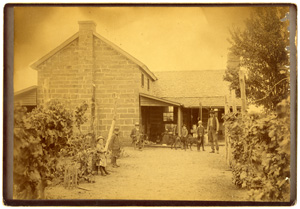
University of Texas at San Antonio - HemisFair '68
 Working with the UTSA Archives and Special Collections, we’re digitizing 1,000 photographs of the 1968 HemisFair, “The Confluence of Civilizations in the Americas.” The images, photographs and slides document the fair - the only international exposition ever held in Texas - from the construction of buildings, to visits by important people such as Lyndon B. Johnson, Lady Bird Johnson, John Connally, and Henry B. Gonzalez. From April to October of 1968, over 6 million people visited the fair, which brought international attention to San Antonio and Texas. The photos will be online starting this winter.
Working with the UTSA Archives and Special Collections, we’re digitizing 1,000 photographs of the 1968 HemisFair, “The Confluence of Civilizations in the Americas.” The images, photographs and slides document the fair - the only international exposition ever held in Texas - from the construction of buildings, to visits by important people such as Lyndon B. Johnson, Lady Bird Johnson, John Connally, and Henry B. Gonzalez. From April to October of 1968, over 6 million people visited the fair, which brought international attention to San Antonio and Texas. The photos will be online starting this winter.
Meet Josh Kasten, student assistant in the Digital Projects Unit since October 2009. Josh was born in Wisconsin, but grew up on a farm in Northeast Indiana. Josh is a military veteran, who served in the Army from 2000 – 2005. After his training at various bases in the U.S. specializing in electronics, he served in Baghdad, Iraq from March 2004 – January 2005, mostly, “driving trucks on  convoys and doing guard duty.” He was hit by a mortar in October 2004, and his leg was injured. He came back to the US in January 2005 and was discharged in June 2005.
convoys and doing guard duty.” He was hit by a mortar in October 2004, and his leg was injured. He came back to the US in January 2005 and was discharged in June 2005.
He is now a student at UNT working on a degree in history, and expects to graduate in May of 2010. After graduation, he intends to do what he has always wanted to do -- teach history at a high school and coach football. He hopes to move, “out west, to the mountains.”
Josh says he has learned a lot about Texas while working in the Digital Projects Lab. One of his favorite projects has been the history reports done by students at Marfa High School. Rather than being a collection of things on one topic, this project has a lot of variation with some interesting essays.
Josh finds it fascinating to see how sparsely populated pasture lands have turned into the metro areas of Texas in a matter of decades. He likes working with the primary historical documents. He hopes it will make history more interesting for users; he feels that rather than being told what happened by someone else, these collections give people the opportunity to, “… see items firsthand and put the puzzle together themselves – the fun part of history.”
The Hemphill County News ran for almost 30 years, from March 1939 through July 1968. The sole owners of the newspaper were husband and wife, Othello and Elna Miller. He was the publisher and editor and she was in charge of the reporting and advertising. The Portal now has the newspaper online from 1939-1953.
The paper was published in the town of Canadian, Texas, the county seat of  Hemphill County, located in the northeast section of the Texas panhandle. Canadian, Texas was, and still is, a ranching and farming community. It is also known as “Rodeo Town” since it was the first place in Texas to stage a commercial rodeo, back in 1888.
Hemphill County, located in the northeast section of the Texas panhandle. Canadian, Texas was, and still is, a ranching and farming community. It is also known as “Rodeo Town” since it was the first place in Texas to stage a commercial rodeo, back in 1888.
The Hemphill County News began in March 1939. The Millers were soon joined by Earl “Scoop” Clark as their reporter. For a couple of months in 1939 they became a semi-weekly paper with publications on Tuesday and Friday. 1940 saw the inclusion of syndicated news from Bell Syndicate and Western Newspaper Union. The Hemphill County News became part of the Panhandle Press Association in July 1939. By the mid-1940s and 1950s the newspaper was a combination of local-only advertising, syndicated columns, and local stories. Syndicated columns included: Star Dust - Stage, Screen and Radio News, The Hometown Reporter in Washington, Household Memos, The Washington Merry-Go-Round, The Fiction Corner, Around the House, Grassroots, The Bible Speaks, Sportscope, and comic strips. Locally written columns included: Happy Birthday, Local News, 10 Years Ago in the News, and the Classified Ads. It had something for everyone, claiming to be “The Only Paper With Complete Coverage in Both City and Country.”
The town of Bartlett straddles the border of both Williamson and Bell Counties, and settlers began to populate the area in the 1850s. When the Missouri, Kansas, and Texas Railroad made plans to lay tracks through the area in 1881, the citizenry decided to form a town. John T. Bartlett and J.E. Pietzsch donated land for the township, and by 1884, Bartlett could boast a population of 300, a post office, a gin, a hotel, a grocer, a meat market, four churches, and a school.
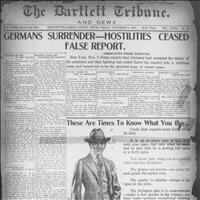 The Bartlett Tribune began publication in 1886, and served a vital role in the community by reporting on national, state, and local news, publishing obituaries, and creating a record of legal notices for the area. As in any community, the newspaper provided the most in-depth means of preserving the stories that formed the town and its citizens.
The Bartlett Tribune began publication in 1886, and served a vital role in the community by reporting on national, state, and local news, publishing obituaries, and creating a record of legal notices for the area. As in any community, the newspaper provided the most in-depth means of preserving the stories that formed the town and its citizens.
With partners at the Bartlett Activities Center and Historical Society of Bartlett, UNT created a plan to microfilm, digitize, and provide free online access to the Bartlett Tribune between 1902 – 1972. This project was made possible by a grant from U.S. Institute of Museum and Library Services to the Texas State Library and Archives Commission under the provisions of the Library Services and Technology Act. Editor and owner of the Tribune-Progress, Gayle Bielss, graciously granted copyright permission for UNT to host this newspaper online.

Libraries Digital Projects Unit receives $631,720 grant
The UNT Libraries have received a two-year grant from the Institute of Museum and Library Services (IMLS) to investigate collection development needs related to online government information.
Working with the Internet Archive, project investigators will research several methods of classifying materials from the 2008-09 End-of-Term Web Archive of the .gov and .mil domains. In addition, UNT will develop metrics for measuring units of selected materials in Web archives -- allowing archived materials to be quantified in a way that is more familiar to libraries and university adminstrators. For more details on this project, please see the UNT News Service Story.
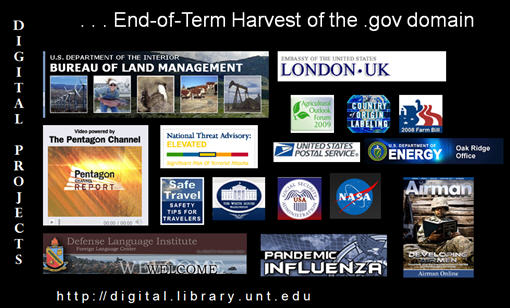
The CyberCemetery: where Federal Agencies go to die . . .
What happens when a federal agency ceases operations and closes its door? Since 1997, the UNT Libraries have been harvesting the websites of defunct goverment agencies, and making them permanently accessible to the public. Much of this information would have disappeared forever if UNT had not captured it. Due to our role in creating the CyberCemetery, and other vital government-related digital materials, the UNT Libraries exist as one of only ten Affiliated Archives of the National Archives and Records Administration (NARA), and is the only university in the U.S. to hold that distinction with the U.S. Naval Academy and West Point.
Examples of some of the archived websites include the Commission to Strengthen Social Security, the National Drought Policy Commission Home, the National Bioethics Advisory Commission, and the United States Information Agency.
 |
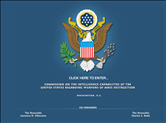 |
 |
|
| Columbia Accident Investigation Board | Commission on the Intelligence Capabilities of the United States Regarding Weapons of Mass Destruction | Presidential Advisory Commission on Holocaust Assets in the United States |
Exciting new Portal features released! We need to hear from you! Select Brief Survey from any Portal page. |
Hot Comments Dr. David Gracy on using the Portal for his upcoming book about the Centennial of the Texas State Library: "I used the Portal extensively for Gammel's Laws. With my study of the history of the state library and archives of Texas covering nearly 160 years of a state agency, the number of occasions on which I needed the exact wording of a statute, or some specific of an appropriation, or the exact name of a member of the legislature, or some other fact were beyond count. Without question, having the resource on the Portal in such a way that I could search for specific wording in the text, as well as move from one period to another, was heaven. If for every one of these information needs, I had had to find my way to a library holding this specific resource, my work would have been strung out more than time would have allowed. In other words, the history I am completing would not have been as thorough and as fully informed as having the Portal has empowered me to make it. - Dr. David B. Gracy |
Image of the month This wonderful image of Fort Worth aviation workers demonstrating the different varieties of safety goggles comes from our partners at Lockheed Martin Aeronautics Company, Fort Worth. |
| Mission
Statement The Portal to Texas History offers students and lifetime learners a digital gateway to the rich collections held in Texas libraries, museums, archives, historical societies and private collections. |
Sign up for the Portal to Texas e-Newsletter! Please forward this newsletter to friends, family, or anyone else who loves Texas history! If you'd like to sign up for our newsletter, just click the link above and send the email. |
It's Online!! The Abilene Photograph Collection consists of over 10,000 images - this delightful assortment of images of community members, homes, businesses, churches and ranches details Abilene's rich history, capturing a multitude of public events in Abilene and surrounding areas. |
The Portal on Facebook If you are on Facebook, join the Portal to Texas |
Who knew? you can find anything on the A search for "band" finds 5,052 results. Here are a few. Missouri Pacific Railroad Booster Band, Palestine Public Library Baton Twirlers, Abilene High School Band, Hardin Simmons University The Frantics rock band, 1970, Hardin Simmons University Band Concert in Mesquite, Dallas Community College District Taping a band at KTBC in Austin, Austin History Center Woman singing in front of a band, Austin History Center |
Contact
Us
Beyond the Bytes is a free electronic newsletter emailed to subscribers of our listserv. Dreanna Belden,
Editor: Tara Carlisle,
Editor: Ann Howington, Contributor UNT Libraries
|
See our back issues: July 2009 |

